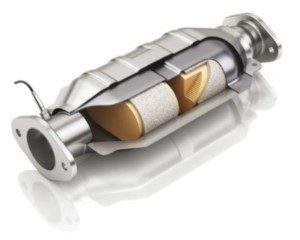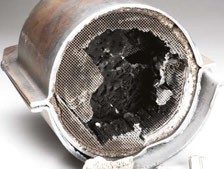By William J. Doria
It’s hard to imagine living without cars or trucks! They help us to travel long distances quickly and easily, and also to send and receive deliveries. But unfortunately, there are problems with how much we depend on cars and trucks. One big problem is that the gasoline and diesel they use creates exhaust, which contains many different gases that pollute our air and water. The pollution can lead to very unhealthy air and, over decades, can even cause climate change. What makes the exhaust so bad for us, and how can we improve it?
One of the gases in exhaust is called carbon monoxide (CO), which is a poisonous gas that’s fatal to breathe in large amounts. Other gases in car exhaust are called hydrocarbons (because they’re made up of atoms of hydrogen and carbon), and they can contribute to climate change. Two other ingredients in exhaust are nitric oxide (NO) and nitrogen dioxide (NO2), which lead to acid rain. Acid rain damages the trees in forests, and makes the water unhealthy for fish and plants that live in ponds, lakes, and streams.
That all sounds pretty bad – so how can we solve the problem of automobile pollution? That’s where chemists come in! All those polluting molecules eventually break down and form other molecules that aren’t as bad for the environment. But those chemical reactions take a long time, so chemists use what’s called a catalyst. A catalyst is a substance that helps a chemical reaction happen faster.
You’ve probably seen the results of catalysts without even realizing it! For example, do you like bread, cheese, or yogurt? In order to make these types of food, we need to perform a chemical reaction called fermentation. Fermentation is usually too slow to use in cooking, so we add a catalyst to speed up the reaction! For bread, that catalyst is in the yeast we add to bread dough.
Chemists have learned how to use catalysts to speed up the reactions that break down car exhaust. If your family’s car runs on gasoline, it has a device called a catalytic converter. Inside this device is the catalyst, which is a piece of metal — usually platinum, palladium, or rhodium. These metals are valuable. The metal is coated onto a ceramic mesh that looks kind of like a screen you might have in your windows at home.

When a car’s exhaust goes through the mesh, and pollutant molecules stick to the metal. When these molecules get stuck to the metal, some of their chemical bonds are weakened and it becomes easier for them to have effective collisions with other molecules. As a result, they quickly undergo chemical reactions that turn them into less harmful gases. For example, carbon monoxide (CO), and oxygen (O2) combine to form carbon dioxide (CO2), which isn’t as dangerous as carbon monoxide. And because the metal is a catalyst, the reaction happens much more quickly than it would without the catalytic converter.

Catalytic converters work really well! A brand-new one catches about 99% of the pollutants mentioned above, and converts them into safer chemicals. Thanks to catalysts in your car, we can all breathe a lot easier!
William J. Doria is Assistant Professor of Chemistry, Rockford University in Rockford, IL.

